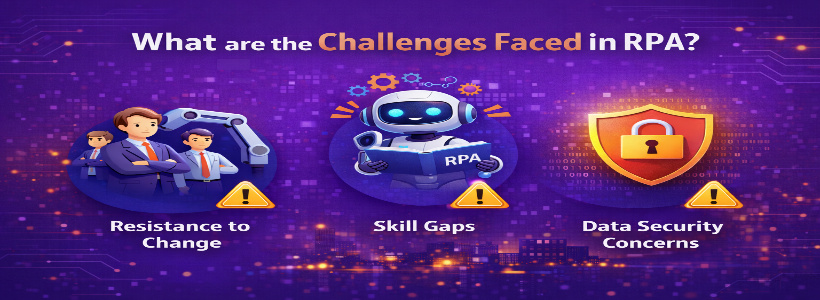
Through the automation of tedious procedures and duties, robotic process automation, or RPA, has completely changed the way enterprises run. These challenges can range from technical complexities to strategic misalignments for successful implementation of RPA. In this blog, we will explore the top five challenges in RPA and how UI Path, one of the leading RPA platforms, addresses these issues. Additionally, we will discuss the current limitations of RPA, whether it can run 24/7 without errors, situations where RPA may not be applicable, and processes that are not suitable for RPA.
1. Scalability Challenges
Challenge: One of the most significant challenges in RPA implementation is scalability. While it's relatively straightforward to deploy RPA for a single task or department, scaling it across an entire organization can be complex. This complexity arises from the need to integrate RPA with various systems, manage numerous bots, and ensure consistent performance across different environments.
Solution: UI Path offers a robust and flexible architecture that supports scalability. The platform’s Orchestrator allows businesses to manage, deploy, and monitor thousands of bots from a centralized location. UI Path's ability to integrate with a wide range of applications and systems, combined with its powerful analytics tools, ensures that businesses can scale their RPA initiatives seamlessly. The platform's cloud capabilities further enhance scalability, allowing organizations to add or remove bots as needed without significant infrastructure changes.
2.Complexity in Process Selection
Challenge: Tough decision when choosing which processes should be automated because it can affect the RP project’s success. There is a possibility that instead of improving on an idea, it becomes automated wrong processes hence strains resources as well as produces no ROI. RPA performs poorly with complicated, nonlinear, or highly stochastic business processes.
Solution: UI Path selects potential areas for automation. That is why, armed with process and task mining functionalities, UI Path can define what processes should be fully or partially automated based on what has already been introduced into the organization’s workflow. It also consists of number of end-to-end automation templates along with AI capabilities that enable better handling of far more diverse and unstructured tasks.
Want to know the in detail explanation of complexity in process selection? Enroll now at UI Path Online Training
3.Bot Maintenance and Management
Challenge: Bot maintenance and management can turn out to be quite a challenge once there is actually an increase in the number of bots that are in production. Bot stimuli might have to be updated often as a result of modifications relating to the base systems or processes. Uniquely, the bot utilises a number of techniques to remain functional and efficient over time and constantly needs to be monitored and managed.
Solution: UI Path solves this challenge thanks to one of the most robust bot management tools present on the market. The Orchestrator of the platform lets the users track and control the operation of the bots, with notifications of any possible problems that occurred. UI Path also has supplies for version control, for businesses to realize they can modify and manage values of the bot as processes alter. Moreover, it is an automatic system that does not require the user to constantly monitor its performance, but the application has in-built analytics and reporting that would report any problem with the bots for organizations to address possible maintenance challenges.
4.Integration with Existing Systems
Challenge: Typically RPA solutions require access to various applications, such as old systems, cloud and locally developed applications. From the experience we can realize that integration of such systems can be quite complex due to various factors like use of older and relatively inflexible technologies.
Solution: The system integration is UI Path’s strong suit due to the various connectors and APIs that it offers. The platform is compatible with a wide variety of database applications, old-fashioned and up-to-date cloud services. When it comes to integrating different applications, UI Path provides an easy way of doing so through its drag and drop console, also its has access to a broad range of activities and connectors, implying that it can easily integrate with most of the commonly used applications. However, in more demanding cases, users can resort to custom scripting, thus enabling UI Path to connect their bots to any system that a business may have.
5. Security and Compliance
Challenge: Security remains one of the biggest issues in RPA, especially should the bots be working on or with sensitive data. It is very important for organizations to make sure that the RPA they are implementing meets the regulatory laws of the industry and the security policies of the company to prevent cases where the bots might bring about a situation whereby sensitive data is leaked or a security break in takes place.
Solution: Specifically, UI Path is a tool that has the functionality of security and compliance integrated into its design. The features such as RBAC, encryption, and audit trails are present in the platform that enable the bots to work safely and as per the regulation norms to the company. UI Path has a tool called Orchestrator for managing bots used by the business; one can set several security policies and monitor whether the bot tries to perform any violating actions. Further, compatibility with other security systems is another benefit of the platform to guarantee that RPA implementations can combine with other security strategies.
Current Limitations of RPA
While RPA offers significant benefits, it also has some limitations that businesses need to be aware of:

• Lack of Cognitive Abilities: Traditional RPA does not have cognitive capabilities, and doesn’t have the capacity to dictate decisions based on unstructured data or past experience. This means it is only useful where the decision to be made is complicated or where the process calls for creativity.
• High Initial Costs: However it is also important to note that the initial setup and deployment of RPA can initially prove to be expensive if the organization is small. They may involve the expenses in licensed software, tools and infrastructure, time and effort required to build, develop and deploy bots.
• Maintenance Requirements: RPA bots are intelligent, but they need the help of people from time to time to remain working good because the systems and processes that support the bots change. This can mean extra cost and work requirement in future time periods, which is another problem of using this approach.
Want to know the limitation of RPA by experts? Enroll today at UI Path Online Course
Can RPA Run 24/7 Without Making Mistakes?
One more strength of RPA is that the bots can work round the clock round the year. However, whether they can run continuously without errors depends on several factors:
However, whether they can run continuously without errors depends on several factors:
• Bot Design: There are two major challenges that may occur in a bot, if well designed and tested it can work for months. However, poorly designed can be erroneous most of the times more so when handling input or system changes.
• System Stability: Computational entities such as bots rely on certain level of stability of the systems within which they operate. In case either of these systems or both have downtimes or undergo changes, then the bots will fail or yield wrong results.
• Monitoring: It is mandatory to monitor bots constant from which a solution to anything that goes wrong will be developed. For real time monitoring and alerting on possible errors and assures the continuous running of the tool, UI Path’s Orchestrator is used.
In Which Cases Will RPA Not Apply?
This is techniques means that RPA is not applicable in every case, in every company or in every situation. Here are some cases where RPA may not be the best solution
• Highly Variable Processes: Activity areas that have high levels of variation or frequent changes are usually not easy to automate through the RPA since bots are programmed to work within strict set rules and patterns.
• Processes Requiring Human Judgment: Some of the tasks that cannot be solved by traditional RPA include such tasks that entail decision making, natural language processing, and recognition of patterns, or creative work.
• High-Cost Processes: Thus, if the cost of automation of a certain process is higher than the value that can be gained from RPA, it is better to abandon this practice. This is usually true for process with less than average number of transactions or where the amount of time to be saved by labor is insignificant.
Want to know more limitations of RPA Enroll now at UI Path Training
Which process is not suitable for RPA?
Some processes are inherently unsuitable for RPA, including:
• Creative Processes: Work that requires ideas, concepts, or thoughts cannot and should not be automated, for example, writing articles, designing clothes, etc.
• Processes with Unstructured Data: Activities where data is sparse, unformatted and unpatterned like, emails or paper based documents are challenging for traditional RPA since it operates best on formatted data inputs.
• Processes Requiring Emotional Intelligence: Some tasks that need to be solved with the help of emotions, for example, customer support, where a specialist feels the client’s pain, are better to be solved by people not robots.
What are the Challenges Faced in RPA
The journey of implementing RPA is fraught with challenges, including:
• Resistance to Change: Concerns with loss of employment might lead to the resistance of RPA by employees in an organization. To address this resistance, change management as well as communication have to be effective.
• Skill Gaps: Challenges associated with Implementing RPA: A major challenge is that the implementation process entails skills and expertise that are usually not available in the organization. This can be solved by training or employing experienced workers into the company so that the right procedures are followed.
• Data Security Concerns: That is why data security for its sensitiveness since bots deal with various data types in their operation. Only proper measures have to be taken by the organizations in order to prevent the occurrence of a breach or not to failed the regulation.
Conclusion
It was pointed out that RPA brings much value, however, it also has certain drawbacks. However, recognition of these issues and support of a robust base such as the UI Path, businesses can apply and enhance the RPA program with confidence. But there should be a clear understanding of the limitations of RPA and should be very cautious while choosing the processes for automation to get the optimum returns out of the investment made on RPA.Want to know more on UI path? Enroll now today at UI Path Training offered by OnlineITGuru and become a certified professional. Call us today